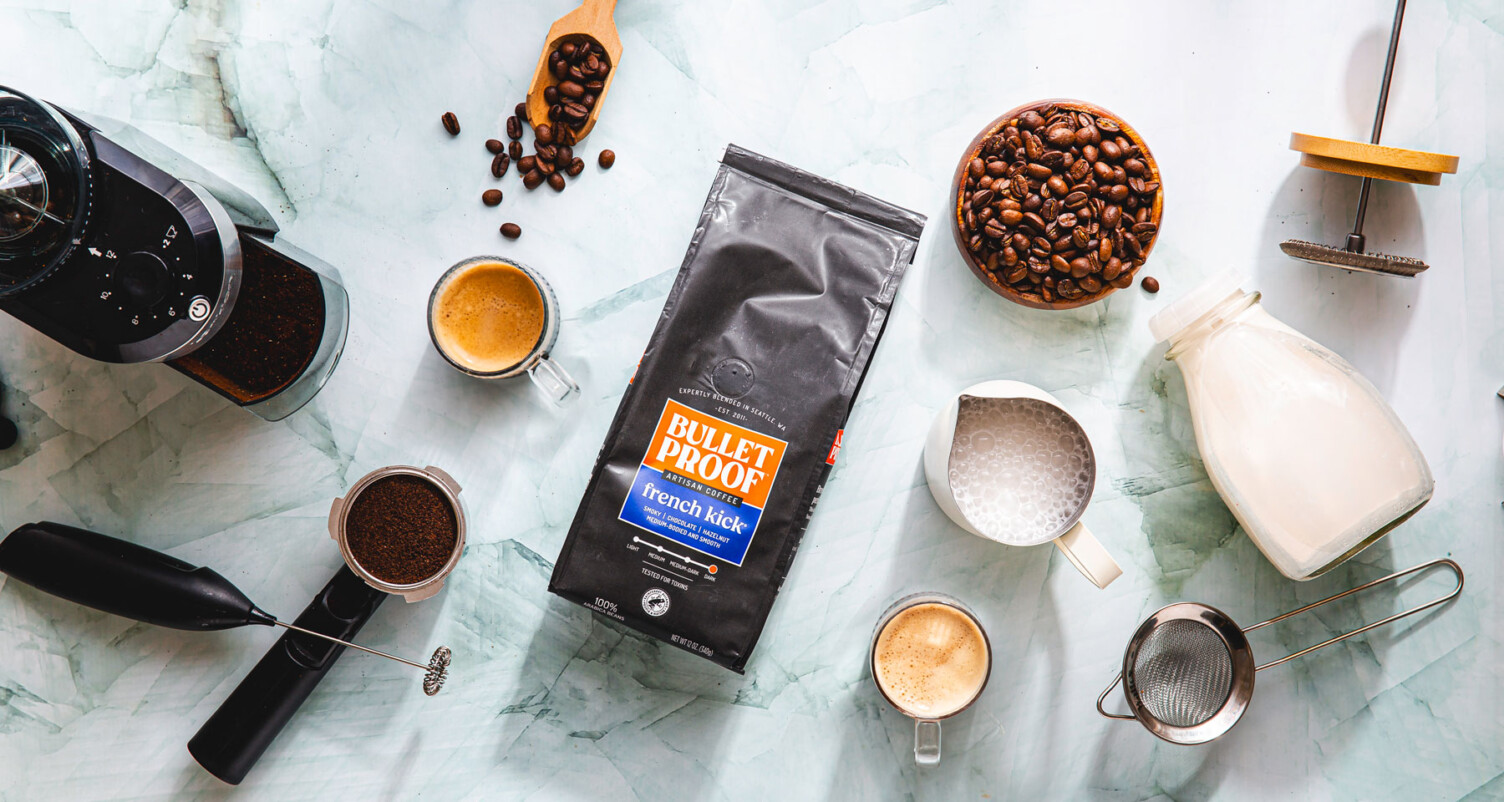- Learn the difference between a latte and a cappuccino and how to make the best recipes for each using Bulletproof coffee.
- Discover the tools needed as well as alternative methods of brewing espresso style coffee that do not require an espresso machine.
- Tips and tricks on how to create latte art and impress your guests.
What’s the Difference Between a Latte and Cappuccino?
Lattes and cappuccinos are made using the same ingredients in different ratios. Both are made with a shot of espresso that is layered with steamed milk and milk foam in different ratios.
Lattes have a lot more steamed milk and a small amount of foam, while cappuccinos have the opposite.
Lattes tend to be larger drinks and, due to their high milk content, are frequently made with a double shot of espresso. Cappuccinos have a stronger coffee flavor and are much less milky.
Essential Equipment for Making Lattes and Cappuccinos
If you are really serious about making lattes and cappuccinos at home, we recommend investing in a small consumer-grade espresso machine. Professional espresso machines can be large, expensive, and intimidating to use, but there is a great selection of good quality, smaller scale machines that will work just fine for the typical coffee lover.
A moka pot or french press are also great alternatives that can be used because they allow you to control variables such as the strength, temperature, and speed of the brew in order to achieve a flavor comparable to espresso.
If you only have a regular drip cup coffee maker, just double the coffee to water ratio, ensuring you have a really strong brew of coffee.
There are also many tools you can use to steam and froth the milk. Heating milk in a sauce pan and whipping with a hand frother is an easy way to prepare the milk just like how an espresso machine would.
If you don’t own a frother, you can use a french press coffee maker to plunge air into milk or vigorously whisk or shake the milk in a mason jar.
The Best Milk for Lattes and Cappuccinos
Any milk is acceptable to use in a latte or cappuccino, although some steam and froth better than others. For the best dairy option, you cannot go wrong with whole milk which steams and froths perfectly, giving a creamy taste and long lasting foam.
For a non-dairy option, oat milk has a similar creamy texture and neutral flavor as well as a sturdy foam structure.
How to Make a Perfect Cappuccino at Home
Print Recipe
The Perfect Homemade Cappuccino
Barista-quality cappuccinos made in the comfort of your own home.
- 1/3 cup Bulletproof French Kick strongly brewed
- 3/4 cup whole milk
- sugar optional to taste
Grind the coffee beans to a fine consistency and brew an extra-strong cup of Bulletproof French Kick coffee. If you’re using espresso beans and a machine, simply brew a shot of espresso as you normally would.
Heat the milk in a saucepan until it is very hot and remove from the heat just before it begins to boil.
Using a hand frother, whip the hot milk until foam appears and it fluffs up to about double the volume.
Add the steamed milk to a mug and pour the espresso or coffee in the middle.
Spoon a thick layer of foam on top and garnish with a sprinkle of cocoa powder or cinnamon. Enjoy!
- Servings: 8 oz
- Calories: 28
- Fat: 1.5 g
- Protein: 1.5 g
- Fiber: 2 g
- Carbohydrates: 2 g
How to Make a Perfect Latte at Home
Print Recipe
The Perfect Homemade Latte
Barista-quality lattes made in the comfort of your own home.
- 1/3 cup Bulletproof French Kick strongly brewed coffee
- 2/3 cup whole milk
- sugar optional to taste
Grind the coffee beans to a fine consistency and brew an extra strong cup of Bulletproof French Kick coffee. If you’re using espresso beans and a machine, simply brew a shot of espresso as you normally would.
Heat the milk in a saucepan until it is very hot and remove from the heat just before it begins to boil.
Using a hand frother, whip the hot milk until a thin layer of foam appears.
Add the steamed milk to a cup containing the espresso.
Once almost all of the steamed milk has been poured out, tilt the cup and carefully shake the milk foam on top creating swirls or latte art.
Garnish with a sprinkle of cinnamon or cocoa powder. Enjoy!
- Servings: 8 oz
- Calories: 25
- Fat: 1 g
- Protein: 1 g
- Fiber: 2 g
- Carbohydrates: 2 g
Latte Art: Tips and Techniques
Latte art is not required but recommended for an impressive Instagram-worthy drink and an opportunity to show off to your guests. Mastering this skill requires practice, so don’t worry if it takes a few attempts to get it right.
- First, make sure to leave enough space in your coffee cup for the milk to prevent overfilling.
- After steaming and frothing your milk, swirl the coffee cup around to even out the crema, then tilt the cup slightly towards the milk pitcher.
- Pour the milk slowly and play around with the height of the pitcher from the coffee cup, shaking, and twisting the pitcher as it dispenses.
- You can finish a design by “cutting” a line of milk straight through from top to bottom, which gives a traditional latte art look.
- Pouring higher up allows the milk to fall straight through the crema, while pouring close allows the white micro foam to sit on top of the crema.
After getting the hang of the pour, we suggest watching videos of baristas to try out different popular shapes and designs like a heart, rosette, and leaf.
Troubleshooting Common Latte and Cappuccino Problems
Want a fluffy milk foam, but it’s just not frothing properly? Make sure the milk is hot; 130–150°F when frothing.
Do your drinks taste watery and weak or bitter? Brew a stronger cup of coffee or espresso. Reduce the water and increase the amount of coffee grounds. Make sure to use freshly ground beans and grind them to a fine consistency.
Latte foam falling flat? The milk needs a layer of crema to interact with in order to have crisp, clean lines. If you’re using regular coffee or your espresso doesn’t have a nice layer of crema, add a bit of sugar when brewing to help enhance emulsification. If you’re using dairy free milk, try to find the “barista version” of oat milk which is made specifically with specialty drinks in mind and has the closest consistency to dairy milk. Califia Farms, Oatly and Planet Oat have great choices.
Join the Bulletproof Revolution
Sign up for early access to sales, product launches, the latest Bulletproof news and more!














Leave feedback about this